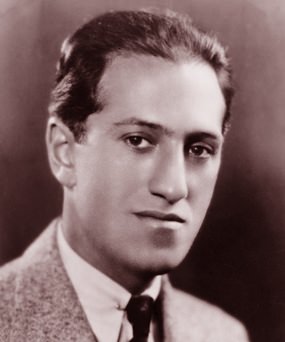George Gershwin had a modest start to his musical career. After leaving school at the age of fifteen his first job was a song-plugger whose task it was to promote new sheet music to customers in music shops or department stores. He worked for the New York music publisher Jerome H. Remick and Company and earned the princely sum of fifteen dollars a week.
Song-pluggers or “song demonstrators” as they were sometimes called, played whatever sheet music was handed to them by customers who presumably couldn’t manage to read it themselves. Gershwin wanted to write songs of his own and his first publication was the crisply entitled, When you want ’em, you can’t get ‘em, When you’ve got ’em, you don’t want ’em. It was published when Gershwin was seventeen and evidently earned him fifty cents. His first big hit was the song Swanee, composed in ten minutes on a bus. Al Jolson, the famous Broadway singer of the day, heard Gershwin perform the song at a party and decided to include it in one of his shows. The song eventually sold a million sheet music copies and an estimated two million records. The year was 1919 and Swanee was the biggest-selling song of Gershwin’s career.
 Modest start: George Gershwin.
Modest start: George Gershwin.
In the following decade Gershwin with his brother Ira churned out a basketful of enduring popular songs such as Fascinating Rhythm, Oh Lady be Good and Embraceable You. Gershwin also turned his interest to the orchestra and became fascinated with the orchestral music of the French composers of the day. In later years, Gershwin also became quite skilled at painting and his last portrait was of his good friend, the composer Arnold Schoenberg with whom he used to play tennis once a week.
George Gershwin: An American in Paris. Los Angeles Philharmonic Orchestra cond. Gustavo Dudamel (Duration: 20:45, Video: 360p)
Gershwin got the idea for this popular jazz-flavoured symphonic poem after arriving in Paris in March 1928. It was a commission from Walter Damrosch who was the conductor of the New York Philharmonic. Gershwin scored the piece for standard orchestra plus celesta, saxophones and four taxi horns which he had managed to acquire in Paris for the New York premiere. But despite his efforts, the work received mixed reviews at the first performance.
In case you are wondering, nowadays most orchestras hire a set of taxi horns when this work is performed. They cost about $100 for a week and they’re normally played – perhaps “honked” – would be a better word – by one of the percussion players.
George Gershwin: Rhapsody in Blue. Herbie Hancock (pno), Los Angeles Philharmonic Orchestra cond. Gustavo Dudamel (Duration: 21:11, Video: 480p)
Rhapsody in Blue dates from four years earlier, before Gershwin had started learning the skills of orchestration. It was commissioned by bandleader Paul Whiteman and the original version was much shorter and scored by Ferde Grofé for Whiteman’s jazz orchestra. An interesting, if somewhat bizarre movie of this early version is on YouTube, billed as Rhapsody in Blue – King of Jazz. It features Gershwin at the piano and it’s introduced by Paul Whiteman who bears an unsettling resemblance to Oliver Hardy.
This later symphonic version has become a staple for classical concert pianists but multi-talented Herbie Hancock brings a fascinating jazzman’s perspective to the score. Hancock made his name in 1963 after he joined the Miles Davis Quintet but then moved on to carve out his own unique niche in music.
Conductor Gustavo Dudamel is entertaining to watch and clearly someone who loves his job. He has the entire orchestra literally at his finger-tips. And notice that he doesn’t use any music. Like the best conductors, he has the score in his head, not his head in the score.
George Gershwin: Cuban Overture. Teresa Carreño Youth Symphony Orchestra of Venezuela, cond. Joshua Dos Santos (Duration: 10:23, Video: 480p)
The Cuban Overture was a result of a two-week holiday which Gershwin took in Havana in February 1932 and the piece is dominated by Caribbean rhythms and Latin-American percussion. Originally entitled Rumba, it’s a joyous yet rhythmically complex work that uses instrumental colour to the full. Several of the catchy melodies were influenced by popular traditional folk songs of the day. Listen closely and at 04:50 onwards, you’ll hear those evocative lush tropical harmonies that Gershwin used in the song Summertime, composed two years later for his opera “Porgy and Bess”.
Incidentally, in the 1920s Gershwin wanted to study with Igor Stravinsky, considered the most influential and successful classical composer of the time. When he approached The Great Man at a party in Paris, Stravinsky surprised him with the question, “How much money do you make a year?” Upon hearing the answer Stravinsky replied, “Perhaps, Mr. Gershwin, I should study with you.”




